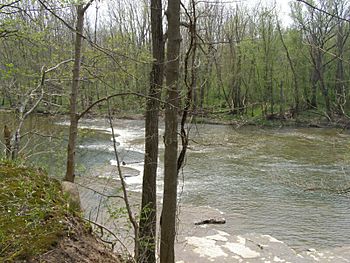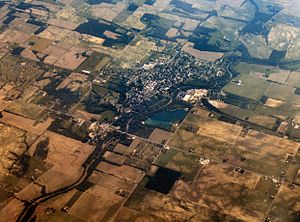Mississinewa River facts for kids
Quick facts for kids Mississinewa River |
|
|---|---|

The Mississinewa River near Marion, Indiana
|
|
| Country | United States |
| Physical characteristics | |
| Main source | Darke County, Ohio |
| River mouth | Wabash River near Peru, Indiana |
| Length | 120 mi (190 km) |
The Mississinewa River is a river in the United States. It flows through eastern Indiana and a small part of western Ohio. This river is a tributary, which means it's a smaller river that flows into a larger one. The Mississinewa flows into the Wabash River. It is about 120 miles (193 km) long. It is the third longest tributary of the Wabash River.
The Mississinewa River is part of a huge water system. Its waters eventually join the Ohio River and then the mighty Mississippi River. This entire area is called the watershed.
During the War of 1812, an important event happened here. A battle took place between United States forces and the Miami Indians. Two ships of the United States Navy were later named USS Mississinewa after this river. The name "Mississinewa" comes from a Miami Indian word. It means "It lies on a slope."
River's Journey: Where the Mississinewa Flows

The Mississinewa River starts in western Darke County, Ohio. This is very close to where the Wabash River also begins. Both rivers start as small ditches that help drain water from local farms. In dry times, they might not have much water here.
After leaving Ohio, the Mississinewa River flows only through Indiana. It first moves west through Randolph and Delaware counties. In many places, its path has been made straight by people. Then, it turns northwest. It flows through Grant, Wabash, and Miami counties.
Finally, the Mississinewa River joins the Wabash River. This meeting point is in Miami County, about 2 miles (3 km) east of Peru.
Along its path, the Mississinewa River passes many towns. These include Ridgeville, Albany, Eaton, and Matthews. It also flows by the cities of Jonesboro, Gas City, and Marion.
You can also find a cool natural spot along the river. About three miles (5 km) southeast of Peru, there are tall limestone rocks. People call them the "Seven Pillars of the Mississinewa."
Controlling the Water: Dams and Lakes
Near where the Mississinewa River meets the Wabash River, there is a large dam. The United States Army Corps of Engineers built this dam. It creates a big lake called Mississinewa Lake. The main reason for building this dam in 1967 was to control floods.
Two other lakes nearby were also created around the same time. Dams were built on the Salamonie River and the Wabash River. These dams were all part of the same big project. Their goal was to stop floods in southern Indiana and protect towns. The Salamonie and Mississinewa rivers both join the Wabash River after these dams.
Historical Events: The Battle of Mississinewa
The Mississinewa River has an important place in history. On December 17, 1812, a battle happened here. Lt. Colonel John B. Campbell led about 600 soldiers on horseback. They were ordered to destroy Miami Indian villages along the river.
The soldiers attacked a village at this site. Two soldiers and eight Miami Indians died. After this, Campbell's group moved two miles down the river. They destroyed two more villages. Then, they came back to this spot to camp for the night.
Early the next morning, on December 18, Miami Indian warriors attacked Campbell's camp. The battle lasted for two hours. Ten soldiers were killed, and 48 were hurt. About 40 Miami and Delaware Indians also died defending their land.
Campbell's group lost over 100 horses. He was worried about another attack. So, he ordered his troops to return to Fort Greenville later that day. This battle was one of the first actions ordered by General William Henry Harrison during the War of 1812. Today, there is a memorial at the site to remember this event.


